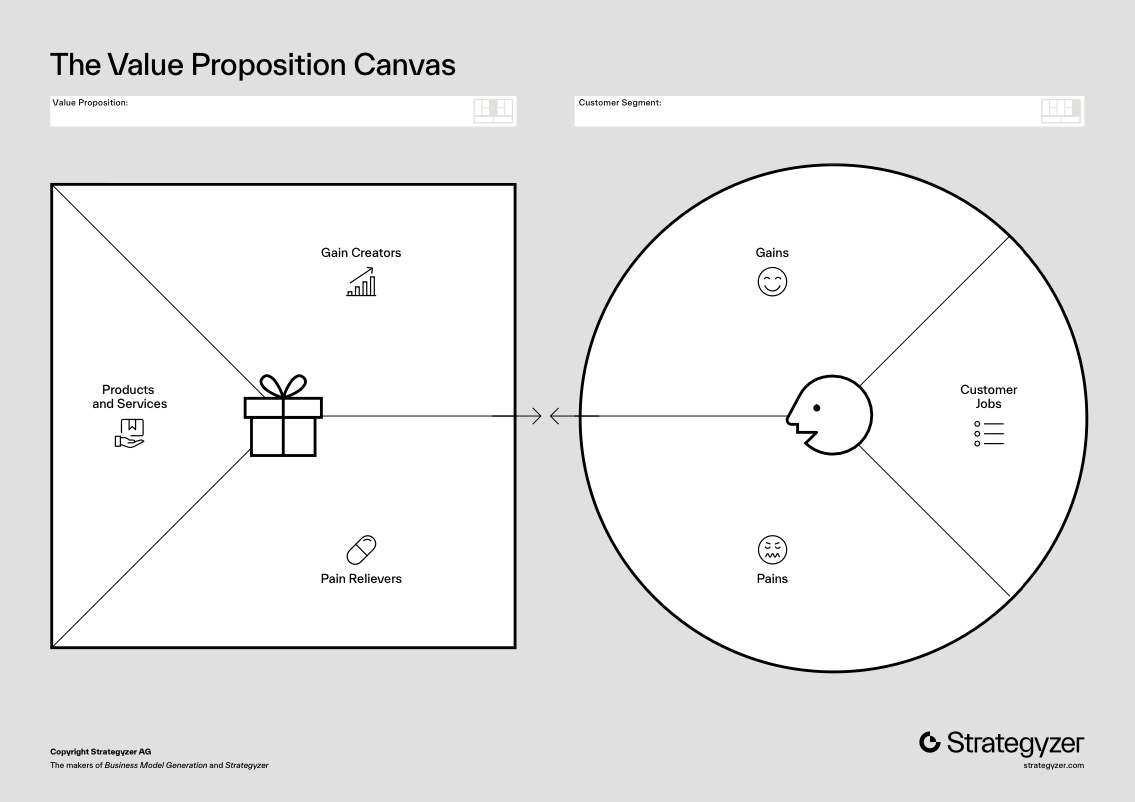An Introduction to the Value Proposition Canvas

Did you know that 72% of new innovations and products don't meet customer expectations and fail upon launch? In a highly competitive market, can you take the chance of being part of that statistic?
Is there a strategic tool that can help you deliver better?
The Value Proposition Canvas emerges as a beacon of hope.
It's not just another business tool but a strategic framework that provides a structured approach to genuinely understand your customers and craft value propositions that hit the mark.
The framework should be used in the early stages of product development, for the following reasons:
- Idea Validation: Before diving too deep into product development, it's essential to validate the idea. The Value Proposition Canvas helps in understanding whether there's a genuine need for the product or service in the market.
- Customer Understanding: At the outset of product development, it's crucial to have a clear understanding of the target audience. The canvas aids in identifying customer jobs, pains, and gains, ensuring the product is tailored to address specific customer needs.
- Product-Market Fit: Before scaling or advancing to later stages of development, ensuring that the product fits the market needs is crucial. The canvas can help refine the product features and offerings based on the value it provides to customers.
- Iterative Feedback: As the product undergoes initial testing or prototyping, the Value Proposition Canvas needs to be revisited to incorporate feedback and make necessary adjustments, ensuring the product remains aligned with customer expectations.
- Pivot Decisions: If, during development, it becomes evident that the product might not meet market needs, the canvas can guide a pivot to a more viable direction.
Toward the end of the article, you will find a handful of other statistics to showcase why you should consider using a framework that works.
What is the Value Proposition Canvas?
The Value Proposition Canvas is a strategic tool that helps businesses design products and services aligned with customer needs. It helps understand customer jobs, pains, and gains, and how a business's offerings can address these areas.
This canvas ensures that businesses create value propositions that truly resonate with their target audience, leading to increased innovation and commercial success.
The Value Proposition Canvas was developed by Dr. Alexander Osterwalder, a renowned thought leader in the world of business model innovation. He co-founded Strategyzer, a company dedicated to providing tools and content for strategic management and innovation.
Read more at the bottom of the article about Osterwalder and his incredible work for business innovation and development.

The core elements of Value Proposition Canvas
Within the Value Proposition Canvas, the two key components are "Value Map" and "Customer Profile”.
The Value Map outlines how a product delivers value, while the Customer Profile captures the audience's needs and challenges.
Together, they ensure a product truly resonates with its users.
The Customer Profile
The Customer Profile is a snapshot of your audience's needs and challenges. It helps you understand what your customers truly want, ensuring that your products and services hit the mark.
- Jobs: The tasks your customers aim to achieve, which can be:
- Functional (e.g., daily commuting)
- Social (e.g., gaining peer recognition)
- Emotional (e.g., attaining mental peace)
- Pains: The hurdles or challenges customers encounter. These could range from dissatisfaction to unforeseen risks or other undesired outcomes.
- Gains: The positive outcomes or benefits customers aspire for, from tangible results to aspirational milestones.
This profile is dynamic, evolving, and becoming sharper as businesses dig deeper into understanding their customers.
The Value Map
Acting as the blueprint of the canvas, the "Value Map" points out how your product or service meets the needs of your customers. It's a guide to showcasing the unique benefits and solutions you offer.
- Products & Services: A rundown of what your company brings to the table.
- Pain Relievers: How your offerings mitigate customer pains, through (innovative?) features or solutions.
- Gain Creators: The ways in which your products or services amplify the positive outcomes customers want
The primary goal of the Value Map is to create a clear link between customer needs and your products or services, guaranteeing that they are well-matched and in harmony.
Benefitting From the Power of a Robust Value Proposition
A value proposition is more than a glorified selling point. It is your commitment, the compelling reason for customers to opt for your product over competitors.
However, a word of caution: even the most captivating value proposition can waver if not anchored by a solid business model.
To truly become a triumphant company you need to turn your value propositions into scalable, profitable business blueprints.
Example of the Value Proposition Canvas in Action
Example Use Case: A Health and Fitness Mobile App
1. Customer Profile (Right Side of the Canvas)
- Customer Jobs: Identify the main tasks the target customers want to accomplish. For example, losing weight, building muscle, tracking daily exercise, etc.
- Pains: Recognize the difficulties or challenges customers face. For example, lack of motivation, difficulty tracking progress, expensive gym memberships, etc.
- Gains: Understand the benefits or positive outcomes customers seek. For example, improved health, feeling more energetic, looking better, etc.
2. Value Map/Proposition (Left Side of the Canvas)
- Products & Services: Outline the features of the app, such as personalized workout plans, diet tracking, social community, etc.
- Pain Relievers: Explain how the app addresses customer pains. For example, providing motivational reminders, easy-to-follow workout guides, affordable subscription plans, etc.
- Gain Creators: Describe how the app delivers gains to customers. For example, offering progress tracking, connecting with friends for support, providing expert advice, etc.
Concluding Thoughts
The Value Proposition Canvas stands out as an invaluable asset for businesses aiming to craft products and services that customers would resonate with. By leveraging insights from using the Value Proposition Canvas businesses can position themselves not as part of the 72% that miss the target but as pioneers in innovation and customer delight.
Online resources
- The official version of the Value Proposition Canvas from Strategyzer
- The Value Proposition House framework was developed by Philips
Who is Dr. Alexander Osterwalder?
Dr. Alexander Osterwalder is an acknowledged thought leader in the world of business modeling and innovation. He co-founded Strategyzer, a company dedicated to providing tools and content for strategic management and innovation.
I first ran into his work while working at Smart Innovation Norway, where we focused on lean innovation, supporting emerging companies, especially in the fields of energy, health, and AI.
He has written a number of books and at Strategyzer you will find their Knowledge Library highly valuable.
Books:
- Business Model Generation - Co-authored with Yves Pigneur, is probably the book that has had the biggest impact on startups since its publication in 2010. The book introduced the Business Model Canvas, a groundbreaking tool that has since become a staple in startups and established businesses worldwide. The book offers practical tools and techniques for designing, testing and building business models.
- Value Proposition Design - Building on the concepts introduced in "Business Model Generation," this book delves deeper into understanding customers, creating value, and driving innovation. It introduced the Value Proposition Canvas, a tool that complements the Business Model Canvas by focusing on product-market fit.
- Testing Business Ideas - Co-authored with David J. Bland, this book provides a step-by-step guide to rapidly and effectively test business ideas, ensuring that they resonate with the market.
- The Invincible Company - This book, also co-authored with Yves Pigneur, explores how established companies can continuously reinvent themselves to maintain their market leadership. It provides insights into how companies can manage their existing business while simultaneously exploring new avenues for growth.
Some more reasons to use a canvas?
- FastCompany: “Why Most Venture-Backed Companies Fail,” 75 per cent of venture-backed startups fail.
- Smallbiztrends: After four years 56% of small businesses fail.
- CBInsights: 97% of seed or crowdfunded companies die or become “zombies.”

David Aleksandersen
David Aleksandersen is Chief Revenue Officer at Amesto Growth. He has over 20 years of experience in sales, marketing, and management, both nationally and internationally. David has a Computer Science degree from Østfold University College and is studying Digital Transformation at Oslo Met. Before joining Amesto Growth, he worked as a business advisor at MarkedsPartner, marketing manager at Dataton AB, and as CEO at Smart Simulation AS.


